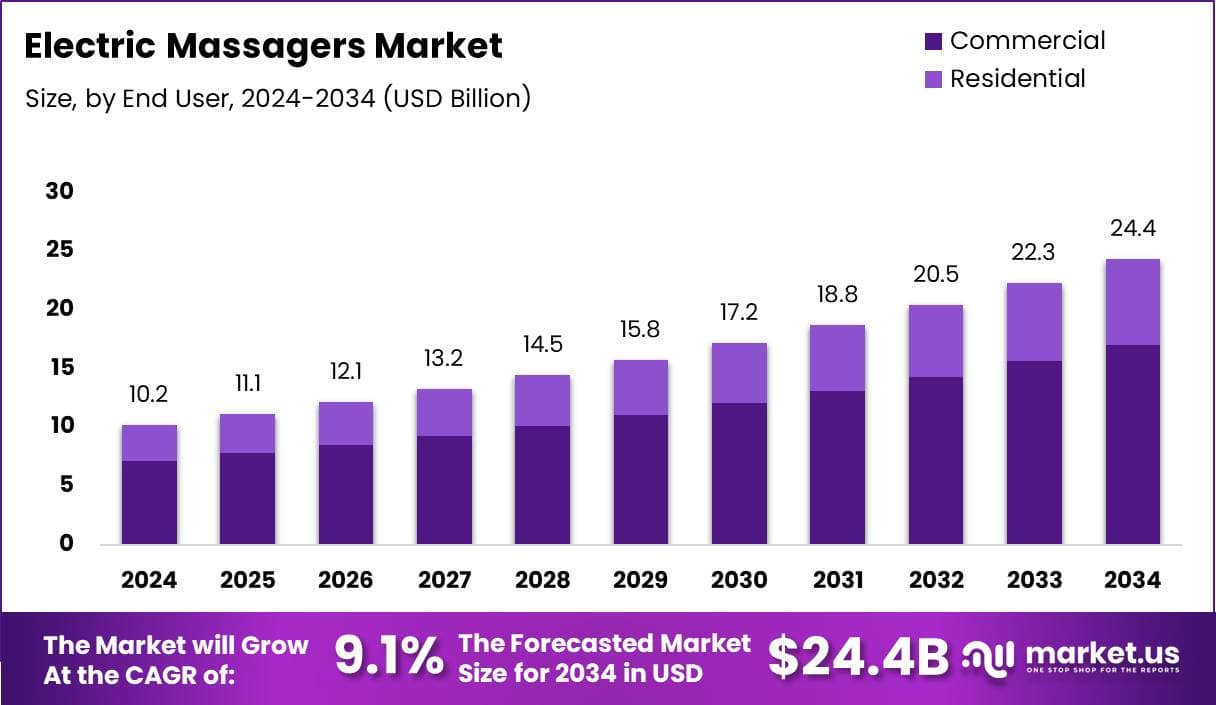Table of Contents
Market Overview
The global electric massagers market is poised for significant growth, with projections indicating an increase from USD 10.3 billion in 2024 to USD 24.4 billion by 2034, reflecting a compound annual growth rate (CAGR) of 9.1%. This growth is attributed to rising consumer awareness of health and wellness, advancements in massage technology, and an increasing preference for home-based therapeutic solutions.
Electric massagers encompass a range of devices designed to alleviate muscle tension, improve circulation, and provide therapeutic benefits. These devices are widely used in both commercial settings, such as spas and clinics, and residential environments. The market’s expansion is driven by several factors, including the growing prevalence of musculoskeletal disorders, increased stress levels, and the demand for non-invasive pain relief options.

Key Market Drivers
- Health and Wellness Trends: There is a growing emphasis on personal health and wellness, leading consumers to seek products that offer relaxation and stress relief. Electric massagers provide an accessible and effective means to address these needs.
- Technological Advancements: Innovations in massage technology, such as smart devices with app connectivity, heat therapy, and customizable settings, have enhanced the functionality and appeal of electric massagers.
- Convenience and Accessibility: The increasing availability of electric massagers through various distribution channels, including online platforms and retail stores, has made these products more accessible to a broader consumer base.
- Aging Population: The aging global population is contributing to the demand for electric massagers, as older adults seek non-invasive methods to manage pain and improve mobility.
Market Segmentation
By Product Type
In 2024, the commercial sector led the Electric Massagers Market with a 69.2% share. This growth is driven by high demand in physical therapy clinics, spas, and wellness centers that require reliable, high-performance equipment for consistent service and reduced manual labor.
By End User
Hypermarkets & Supermarkets dominated the By Distribution Channel segment with a 38.2% share. Their wide reach, product visibility, and promotions encourage impulse buying, making them a preferred choice for consumers, especially in urban and suburban areas.
By Distribution Channel
Neck & Shoulder massagers held the largest share of the By Type Analysis segment at 32.6%. Their popularity is due to the common issues of neck and back pain, especially among office workers, and their ergonomic design that makes them easy to use both at home and in commercial settings.
Regional Insights
North America holds the 52.6% market share, valued at USD 5.3 billion in 2024, due to high purchasing power, wellness awareness, and a growing demand for at-home relaxation solutions. The Asia-Pacific region is expected to witness significant growth, driven by increasing disposable incomes, urbanization, and a rising focus on health and wellness.
Competitive Landscape
The electric massagers market is characterized by the presence of several key players, including Panasonic Corporation, MedMassager, Joicom Corporation, Human Touch, Shenzhen Relcare Electronics, LURACO Technologies Corporation, Dr. Physio, Omron Corporation, Medisana GmbH, JSB Health & Fitness Pvt. Ltd., and HoMedics. These companies are focusing on product innovation, strategic partnerships, and expanding their distribution networks to strengthen their market positions.
Take advantage of our unbeatable offer - buy now!

Conclusion
The electric massagers market is on a robust growth trajectory, driven by consumer demand for wellness solutions, technological advancements, and increased accessibility. As the market continues to evolve, companies that prioritize innovation and consumer-centric strategies are well-positioned to capitalize on emerging opportunities.
Discuss your needs with our analyst
Please share your requirements with more details so our analyst can check if they can solve your problem(s)



